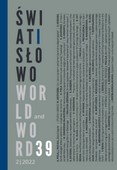Zmiany językowe i tekstowe w kopiowanych dokumentach cechowych jako przejaw świadomości językowej pisarzy na przykładzie ordynacji z 1661 r.
Linguistic and textual changes in copied guild documents as a manifestation of the linguistic awareness of writers based on the ordinance of 1661
Author(s): Iwona Pałucka-CzerniakSubject(s): History of Law, Historical Linguistics, 16th Century, 17th Century, Stylistics
Published by: Akademia Techniczno-Humanistyczna w Bielsku-Białej
Keywords: XVI-XVII centuries; language history; communication strategies; communicative community;
Summary/Abstract: Linguistic and textual changes in copied guild documents as a manifestation of the linguistic awareness of writers based on the ordinance of 1661 This article is devoted to a specific textual phenomenon present in Polish law and legal documents, namely the linguistic changes resulting from the creation of copies. This phenomenon is presented with the example of the guild ordinance of 1661, compiled for the guild of Krakow brewers. The aim of the presented study is also to supplement the knowledge on the use of language in a small, specialized communicative community. The two texts dated 1661, which became the basis for a comparative analysis, are most likely copies of an earlier document from the 18th century. Their copyists fairly faithfully reproduced the content, which they intentionally modified when they noticed the need to adapt the records to the life of the community. Random and misleading changes occurred, but they were sporadic. The copyist made corrections by condensing the content and omitting unnecessary words. The existing grammatical and graphic discrepancies between the texts, as well as the different approach to the form of the Latin text, usually did not change the meaning of the message. Sometimes contradictory tendencies emerged: to shorten the content and condense information, to preserve the signals of the old age of the text, to modernize the linguistic form, and to adjust it to the changed realities. All of them are a manifestation of the writers’ linguistic, stylistic and functional awareness. It can be concluded that the copying strategy, i.e. duplication of the model text of the guild ordinance genre, included permission to make textual, linguistic and stylistic modifications within a strictly defined scope.
Journal: Świat i słowo
- Issue Year: 2/2022
- Issue No: 39
- Page Range: 117-136
- Page Count: 20
- Language: Polish

